[ad_1]
Immigration. Policing. Criminal sentencing. For decades, people have thought that conservative views are caused, in part, by the belief that the world is generally a dangerous place. That’s why we’ve got to keep people out, spend money on guns and the people who wield them, and keep bad guys locked up, right? For example, many journalists, and the public at large, explained the rise of Donald Trump as driven by the belief that the world is dangerous:
Conservatives are driven by fear. It rules their lives. Listen to language they use about immigrants, people of color, new ideas, or any religion that isn’t theirs (itself a system of fear control). They need guns for “protection” and crave authoritarians, even wannabes like Trump.
—Example 2019 tweet tying conservatism to dangerous world belief
The conservatism-dangerous world belief connection was even backed by four decades of empirical studies using a well-validated measure that repeatedly showed that, if the average conservative met the average liberal, the conservative would see the world as more dangerous.
We were wrong.
Our new research, published for the general public for the first time right here, shows that liberals and conservatives actually basically agree about how dangerous the world is. But we do have other deep disagreements about the basic nature of this world, and, as we’ll see, they make a weird amount of sense.

Decades of research suggests conservatives see the world as a more dangerous place where ambiguity hides threat, but this appear
Source: Andreas Wolochow/Shutterstock
But to get there, we need some context.
Since ancient times, back to the philosophers before Socrates, people disagreed about the sort of world this is. Heraclitus thought the world was defined by change. Pythagoras thought it was defined by beauty. And these beliefs were thought to impact personal well-being.
However, only a handful of these extremely basic world beliefs—called primals or primal world beliefs by researchers—have been studied in modern psychology to see where they come from and how they impact our lives.
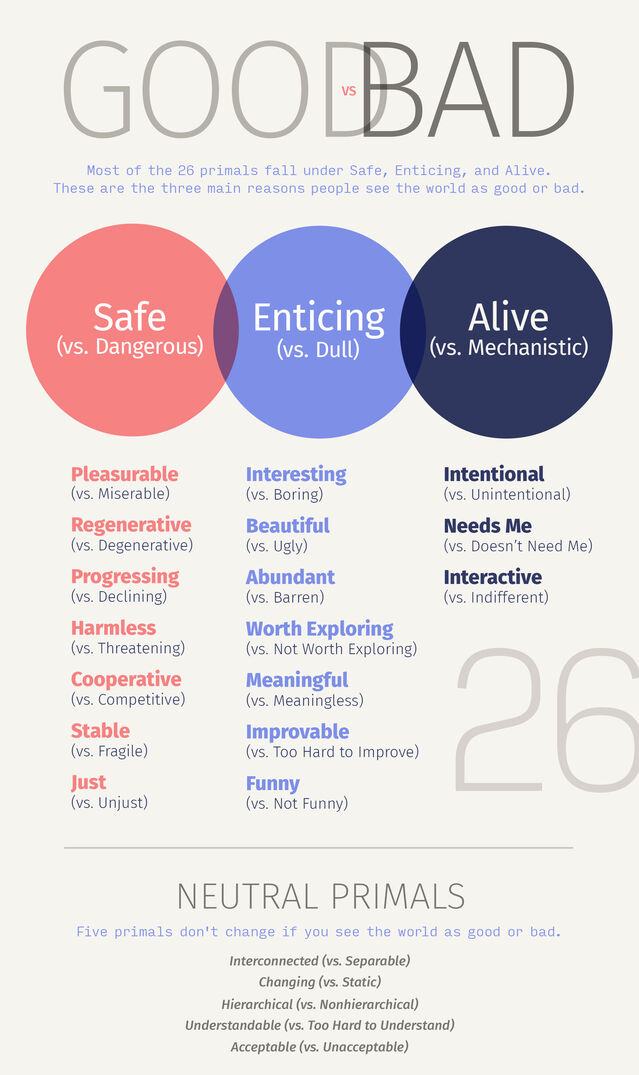
Source: Grey Matter Group
One was called dangerous world belief. It was the view that serious threats and dangers are many and everywhere; the world is a battleground, not a playground. In the 1980s, a measure of this belief was created and validated by scientists.
Though today we know that dangerous world belief is probably most important for clinical and personality research, due to its strong connections to well-being and personality traits, for many years it was primarily studied in political psychology. Unfortunately, they also didn’t know back then that there are seven individual primal world beliefs that, together, make up the overarching belief that the world is dangerous. This was not discovered until 2019, when our team at the University of Pennsylvania finished the first major effort to empirically map all primal world beliefs.
To be clear, instead of coming up with a list of primal world beliefs that we defined ourselves—most researchers try not to do that anymore—we discovered them empirically. To do that, we combed hundreds of the most influential texts in world history, 80,000 tweets that began with phrases like «The world is…», hundreds of the most-used adjectives in English, and much more, to identify a comprehensive set of primal world beliefs people could hold. We then asked thousands of real people about them and used statistical analysis—not conjecture—to reveal underlying data patterns indicating the distinct primal world beliefs that people actually hold. It took five years.
What we found is that humans vary on 26 primal world beliefs, with seven of these clustering into the general belief that the world is, overall, a dangerous place. This dimension was best represented with items like, “On the whole, the world is a dangerous place.” The meaning of the belief was clear.
At that point, having made what most researchers would agree is a more rigorous measure of dangerous world belief, we thought that we’d now find even bigger correlations showing conservatives see the world as more dangerous. It was, after all, well-established. Instead, correlations dropped to almost nothing.
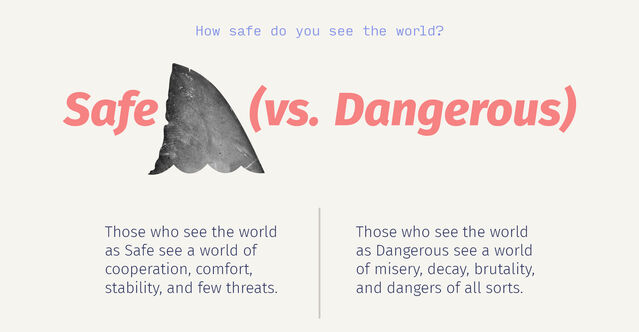
Source: Grey Matter Group
Liberals and conservatives saw the world as equally dangerous.
At first, I thought it was a fluke. I didn’t realize this was a huge deal. For fun, I foolishly shared preliminary results on a personal blog in 2016 that usually got, say, 10 hits a day. (All my mother, I’m sure.)
The post got 80,000 views in three weeks. Multiple press requests followed. I freaked out. I didn’t take any interviews. I didn’t know what this meant yet.
But the same thing happened in a second sample, then a third, then a fourth. Nine samples and 5,500 subjects later, we became pretty sure this is real. Liberals just don’t see the world as a safer place than conservatives.
In the process, we also discovered (and replicated) exactly why we researchers got it wrong before.
The problem was that, of the seven facets of dangerous world belief, the old measure overlooked three ways in which liberals and conservatives agree about how dangerous the world is. It emphasized only the three ways that conservatives see the world as slightly more dangerous (competitive, declining, and physically hazardous) and neglected the one really big way liberals see the world as more dangerous (rife with unfairness).
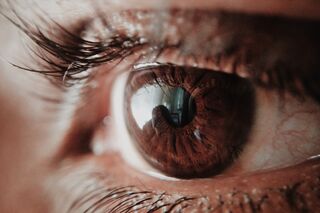
Primal world beliefs concern how we interpret reality.
Source: Subin/Pexels
After all, if outcomes are rarely deserved and unfairness lies around every corner, the world feels pretty dangerous. It’s hard to get a job and feed your family in a world like that.
But even if you took the injustice belief out of the equation and only analyzed six facets—or even if you focused on the facet most specific to immediate physical threat—there is still little difference between liberals and conservatives when it comes to dangerous world belief. No matter how we slice it, dangerous world belief is not actually that relevant.
So, I contacted the creators of the old dangerous world belief scale and shared my findings.
I was scared. Would they be mad? Would they try and suppress this? I was just a lowly Ph.D. student at the time and didn’t yet know how science worked.
But they weren’t mad. They were fascinated. They were encouraging. They even became champions of the need to amend the record and played a key role in its eventual publication at one of the top journals in psychology. (In this era of science doubters, it’s important to highlight when our self-correcting process works, because it usually does. It’s virtually impossible for good science, in the long run, to be suppressed.)
But we all wondered, maybe our findings are just due to how we measured political views?
So, we set about measuring left-right perspectives on 25 different stances, including specific policy views (immigration, military spending, etc.) and candidate preferences (Trump, Bernie Sanders, etc.).
Again and again, we found a similar pattern of correlates. For example, in 2016, it was Sanders supporters, not Trump supporters, who saw the world as slightly more dangerous. Likewise, people who favored increased military spending tended to see the world as safer; the opposite of what we expected.
But these differences were small, too. Basically, dangerous world beliefs just don’t seem important for politics. We’d been barking up the wrong tree.
In fact, when it comes to world beliefs, liberals and conservatives agree on a ton.
Both sides agree on how good the world is (a surprise to some, since both sides tend to see the other as complaining all the time), how beautiful it is, how stable, and even how improvable the world is. (This may help explain why Obama’s message «Yes We Can» resonated across parties in 2008.)
Ok. But where do we disagree? What are the primal differences between liberals and conservatives?
Now we get to it: of all the 26 primal world beliefs, the main difference by far between liberals and conservatives—a difference 20 times larger than the difference in dangerous world belief—concerned a primal called hierarchical world belief. This primal had emerged from our big 2019 statistical analysis with us having no idea at the time that it would matter for politics (or anything else).
Hierarchical world belief is not the view that hierarchies exist—everyone would agree with that—but that hierarchy is inherent to reality. It’s part of the natural order. Not imposed. Not artificial. And not just regarding people. For plants, animals, people, everything, it’s just the way the world is.
Folks who see the world as hierarchical think that almost everything in the world can be ranked from better to worse. Differences probably matter because they distinguish things of more value from things with less. So, when in doubt, respect differences.
(And don’t be fooled into thinking that only those on top think the world is inherently hierarchical. People across social hierarchies appear to see the world as inherently hierarchical at similar rates.)
This fits—weirdly well.
Conservatives do tend to show a default motivation to respect and preserve differences, whether it be borders between countries, differences between sexes, differences between rich and poor, and lots more. And liberals tend to assume those differences are fraudulent or arbitrary. The poor don’t deserve to be poor. The rich don’t deserve to be rich. And so forth.
But a few other primals stood out, too, such that there are actually six major primal disagreements between liberals and conservatives (the figure below from our research article requires a longer explanation, but you get the idea that one red bar is a ton bigger than the other, and a few other bars stood out, too). Together, these six primals paint a picture of two perceived worlds in which an array of opposing political positions make a weird amount of sense.
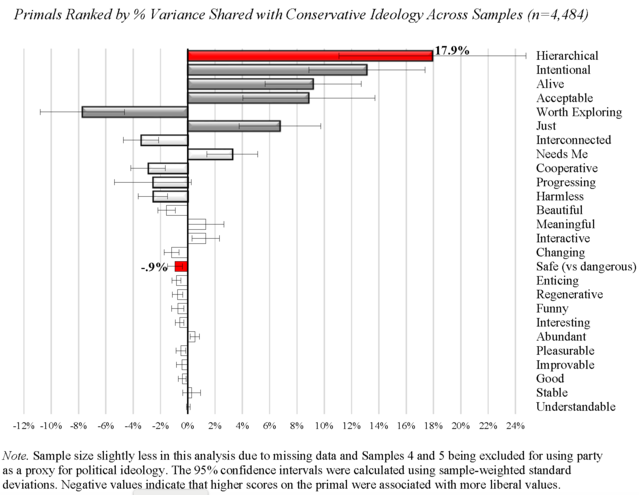
Source: Clifton & Kerry, 2022
What follows is the most complete, up-to-date picture researchers have about what the world looks like from the perspective of each group.
Conservative Reality
Conservatives tend to see the world as a place where, like it or not, observable differences reflect real underlying value (high Hierarchical world belief) that is somehow meant to be (high Intentional world belief) where station and attention received are usually deserved (high Just world belief, low belief that the world is Worth Exploring). Therefore, most hierarchies that emerge are best left as they are (high Acceptable world belief). However, unfortunately, change is slowly eroding the world’s hierarchies (low Progressing world belief). Therefore, constraining change and accepting inequality (the textbook two-part definition of conservatism that researchers use) is just common sense.
Liberal Reality
Liberals tend to see the world as a place where observable differences are superficial, rarely reflecting actual value (low Hierarchical world belief), cosmic purpose or intent (low Intentional world belief), deserved status (low Just world belief), or attention received (high Worth Exploring). Therefore, most hierarchies require reform (low Acceptable world belief). Fortunately, however, the world is getting better and change is taking us in the right direction (high Progressing world belief). Therefore, embracing change and rejecting inequality (the textbook definition of liberalism) is just common sense.
That’s a lot to digest.
Basically, what’s happening here is that the main worldview difference between liberals and conservatives has nothing to do with how dangerous we think the world is but with whether the world is a place where differences usually matter and should, in general, be respected.
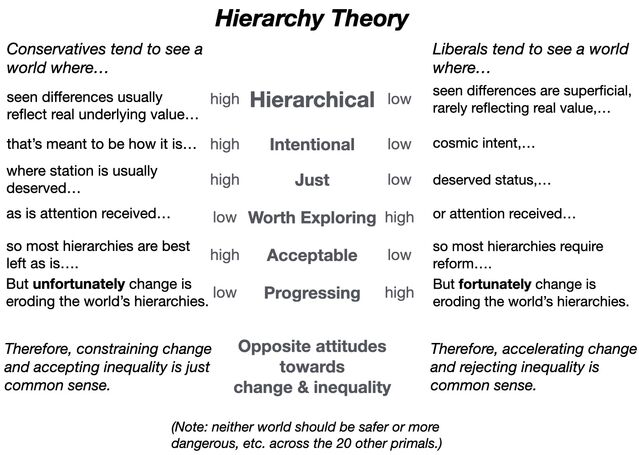
Source: Jer Clifton
Importance for researchers
The conjecture that these six primals cause left-right differences is just that—a conjecture, called Hierarchy Theory—but I think the reader can see why researchers are excited to explore this theory closely. These findings have substantial implications for psychologists figuring out where political views come from, political operatives crafting messages, and historians understanding how the conservative/liberal fault line has shaped history. Fortunately, a big wave of primals research is coming. We are aware of more than 40 research labs worldwide conducting new studies on primal world beliefs, including the primals of politics.

Source: Public domain images
Importance for you
For three reasons, these findings are also important for the average person.
First, we don’t have to hate each other (as much).
As America has become more tribal and plagued by media echo chambers and misinformation, it’s easy to forget that, for many, there remains some honest disagreement about the sort of world this is and what policies are needed. Our discoveries about the primal world beliefs that separate liberals and conservatives is good news because each side can now seem a little less crazy and a little less mean.
After all, if we had the other side’s primal world beliefs, maybe we’d share more political views. Whenever you get ticked at your crazy liberal or conservative friend, maybe read the above paragraphs and try to see the world from their perspective.
This misunderstanding about dangerous world belief has also annoyed conservatives for a long time (here’s one example). Nobody likes their honest, sober-minded views dismissed as a fear response. Now, there’s more reason for people to stop seeing those they disagree with as scared children (at least for primal world belief reasons).
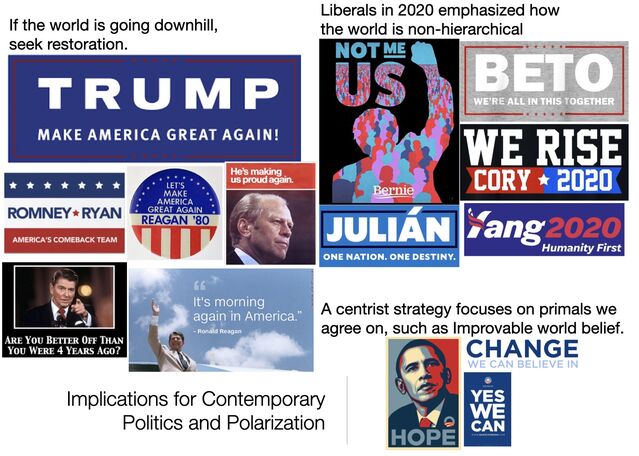
Source: Public domain images
Second, we can get better at perspective-taking.
The beginning of cooperation is not agreeing about everything but seeing the world from the perspective of another. Our research has shown that humanity has spent decades (centuries really, going back to Hobbes) misunderstanding each other. Now, maybe perspective-taking efforts can bear more fruit around dinner tables and capitol buildings.
Third, maybe we can tackle our underlying disagreements.
Could there be a way to move beyond surface-level disagreements (on this or that policy) to respectful discussions of our deeper worldview differences in order to align our primals? If we could find a way to, as a society, get on the same page about what sort of world this is and thus what sorts of policies are called for, it’s hard to see how we wouldn’t alter the future of human cooperation.
Heady stuff. In the meantime, we have one piece of practical advice for everyone:
Know your primals.
If you don’t know your own primal world beliefs and how they likely differ from others, how can you expect others to see the world from your perspective or empathize with it?
The survey that measures all 26 primal world beliefs is online here. Our advice is to take the 99-question version, digest your personalized report, and talk to a loved one about it. Odds are it will open your eyes to new ways of seeing the world. Just don’t take it focused on politics. While relevant to politics, research clearly indicates primals are more relevant to well-being and personality. The most important primal in your life is likely not hierarchical world belief but your overall belief about whether the world is a good place.
As primals researchers, we can’t tell you which primal world beliefs are true, but we can provide some insight into how your primals might be impacting your life.
This article was co-authored with Dr. Nick Kerry, a researcher at the University of Pennsylvania.
[ad_2]
Source link





